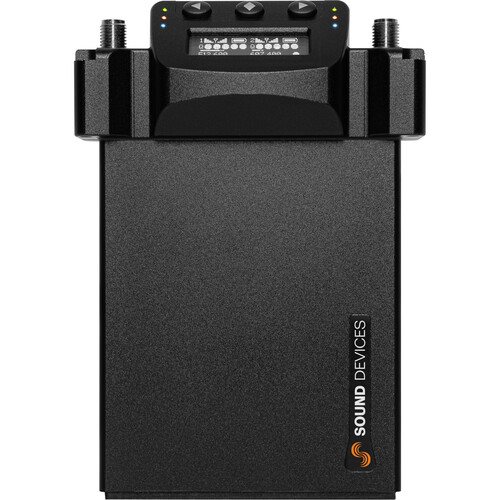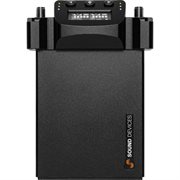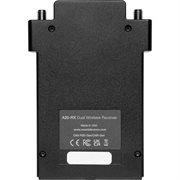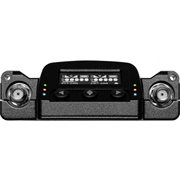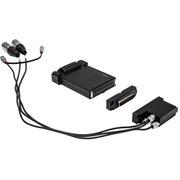- 1800 717 710 | Newsletter |
- FAQ |
- Contact
-
0 product
My Cart - Quick Order
- Home>
- Audio>
- Wireless Microphones>
- Receivers & accessories>
- Receivers >
- Sound Devices A20-RX-XLR Dual-Channel Digital Receiver - 470 to 1525 MHz
Sound Devices A20-RX-XLR Dual-Channel Digital Receiver - 470 to 1525 MHz
Designed for use with the A10-TX and A20-Mini transmitters, the A20-RX-XLR from Sound Devices is a dual-channel digital receiver featuring a powerful feature set that ensures professional-level reliability, even in noisy RF environments. This version includes the A-XLR adapter, which provides XLR audio outputs and 4-pin Hirose powering connections for stand-alone bag use.
SpectraBand technology gives the A20-RX a massive tuning range from 470 to 1525 MHz, allowing for worldwide use, while Advanced Digital True Diversity topology uses two completely independent RF receivers for each channel, providing a total of four receiver circuits to deliver clean reception with fewer dropouts. The system is completely digital, ensuring pristine quality audio at extremely long transmission distances with brick-wall SAW filters to eliminate out-of-band interference. The unit's AutoAssign function automatically scans a tuning band and selects clean, interference-free frequencies for you, saving valuable time on set.
With SpectraBand technology, you won’t need to purchase another receiver dedicated to a specific country or frequency band. SpectraBand gives you access to nearly twice the frequencies available with other systems worldwide – almost 2600 available channels.
SpectraBand Technology: compatible with the A20-Mini from 470 MHz – 1525 MHz and all tuning ranges of the A10-TX
Advanced Digital True Diversity topology uses two complete RF receivers for each of the two channels, with four RF receivers in total
SuperSlot compatible with the SL-2 and 8-Series mixer-recorders
State-of-the-art 100% digital long-range modulation delivers the longest transmission distance of any digital system on the market.¹
GainForward Architecture compatible with the A20-Mini. Set the Mini’s gain levels via trim control (with an 8-Series) or at the A20-RX (for other mixers)
Full 10 Hz – 20 kHz audio bandwidth; 100% digital RF modulation and transmission
Excellent immunity from nearby IFB or camera hop transmitters without the need for external filters or extra cabling
Maximum connectivity: SuperSlot, XLR, and TA3 (coming soon) backplates, A-RXMON headphone amp, and A-15PIN two-channel AES Sony camera slot adapter
Analog line-level or AES digital audio output
Full-Tuning-Range SpectraBand Technology
True-Diversity Reception
Brick-Wall SAW Filters Cut Interference
10 Hz to 20 kHz Audio Frequency Response
Analog or AES Digital Output
GainForward Architecture
Wireless TechnologyDigital UHF
DiversityTrue Digital Diversity
RF Frequency Band470 to 1525 MHz
Frequency Step Size25 kHz
RF Channel ScanningAuto-Scan
Timecode SupportNo
Control App SupportNo
Latency2 to 3.9 ms
ModulationProprietary
Receiver TypeSlot-Mount (Bag Suitable)
Mounting OptionsSlot-Mount (with Optional Hardware)
Antenna2 x 1/4 Wave Flexible Whip, SMA (Front-Mount)
Number of Audio Channels2
Audio I/O1 x XLR (AES3) 3-Pin Male Balanced Mic/Line Output
1 x XLR 3-Pin Male Balanced Mic/Line Output
Slot-Mount I/O Adapters
Available Separately:DB-25 (Uni/SuperSlot)
Audio Output Level14 dBu (Max)
Phantom Power ProtectionNone
Frequency Response10 Hz to 20 kHz
Network I/ONone
Network ProtocolsNone
Word Clock I/ONone
USB/Lightning ConnectivityNone
Standalone Audio Interface CapableNo
Power RequirementsDC Input
Display & Indicators1 x Graphic LCD (Frequency, Multifunction, Peak, RF Level, Transmitter Battery Status)
Operating Temperature14 to 131°F / -10 to 55°C
Dimensions 78.5 x 113.7 x 26.6 mm
Weight165 g (without Mounting Hardware)
Can the A20-Mini be upgraded to transmit with the new wider 470 MHz – 1525 MHz range?
Yes, simply download the free v6.00 firmware and update your transmitter.
Can the A10-TX be upgraded to transmit with the new wider 470 MHz – 1525 MHz range?
No, while the A10-TX will still work wonderfully with either the A10-RX or the A20-RX, it is based on older circuitry which cannot transmit with the wider tuning range.
Can the A10-RX be upgraded to an A20-RX and receive with the new wider 470 – 1525 MHz range?
Yes, this is a significant hardware update which requires a new RF board inside the A10-RX. You can upgrade the hardware of your receiver to the A20-RX for USD$995 or for USD$750 if you purchased your A10-RX within the last 12 months or an A20-Mini since June 1st. The upgrade program lasts until the end of 2022. Start your upgrade at service.sounddevices.com.
Is SL-2, SL-6, and A10-Rack antenna distribution compatible with SpectraBand?
The SL-2 antenna distro has an upper frequency cutoff of 1.7 GHz and is compatible with the full SpectraBand range. SL-6 and A10-Rack have an upper frequency cutoff of 700 MHz and are only compatible with transmitters in 470-700 MHz.
With which receiver is the A20-Mini compatible?
Both the A20-RX and A10-RX receivers are compatible with the A20-Mini transmitter.
Can the A20-RX’s two channels be set to separate tuning bands?
Both channels must fall within the same tuning band, as the brick-wall filtering comes before any of the active circuitry for best performance. With the A20’s tight intermod-free channel spacing of 400 kHz and SpectraBand’s 20+ tuning bands, there are many frequencies to choose from – typically 60 frequencies per band.
Can the A20-Mini use balanced microphones?
The A20-Mini is specially designed for small size, and supports lav mics only. For using 48V phantom, balanced mics or balanced line sources, please use the A10-TX.
What is the Bluetooth range on the A20-Mini?
Many things in the environment can affect Bluetooth range, but line-of-sight you can typically expect up to 40 feet (13 meters).
What’s the difference between the RSSI and Q-meter?
The RSSI is a visual representation of how well the antennas on the receiver are picking up a wireless microphone. The Q-meter displays the difference between the signal from the transmitter and any interference. Use the Q-meter to confidently choose frequencies which will give the best performance and range. Learn more about the Q-meter at sounddevices.com/quality-meter
What’s the difference between Standard and Long Range Modulation?
When compared to Standard Modulation, Long Range has better sensitivity. This results in more robust performance in challenging RF environments. Standard modulation has a latency of 2 ms, while the long range modulation has a latency of 3.9 ms.
Can the A20-Mini use both 2-wire and 3-wire lav microphones?
Yes, unlike the A10-TX which only supported lavs which are 2-wire, the A20-Mini also supports 3-wire lavs such as the Schoeps CMR.
On the A20-Remote app, I notice a “License” icon near the frequency I have set. What is this?
This icon is a friendly reminder that you legally need a license from your local government to operate on this frequency.
I notice that the green audio LED glows with audio no matter what the GainForward gain is set to. Why doesn’t the brightness of the LED change?
The green audio LED on the A20-Mini is a very wide dynamic range indicator and thus indicates the entire dynamic range of the microphone. It is designed *not* to change with any gain settings. This indicator is used for a quick visual indicator that the microphone is working.
When is simultaneous record and transmitting available on the A20-Mini?
A20-Mini transmitters purchased in the United States of America do not have a simultaneous record and transmit (REC + RF) mode.
A20-Mini transmitters purchased outside the United States of America have a REC + RF mode. This mode is available when operating outside of the United States.
REC + RF mode is not available on any A20-Mini while operating in the United States.
How robust is the A20-Mini’s plastic chassis?
The A20-Mini’s chassis has an exceptionally high strength-to-weight ratio thanks to its aluminum/high-strength Ultem thermoplastic construction. Additionally, each piece of the chassis is curved in both directions, imparting a very stiff geometry. All together, the chassis feels very light, but extremely solid.
Why is the A20-Mini branded as Sound Devices and not Audio Ltd?
Sound Devices and Audio Ltd got married back in 2018. Though we both speak (more or less) the same language, we live in two different houses. Now you get both wonderful groups under one simple name, Sound Devices.
How many groups can I make in A20-Remote?
You can make one custom group with any transmitters you select. There is also an automatically-created “All Transmitters” group.
GainForward
Is the Bluetooth connection being used to remotely control the gain of the transmitter?
No, there is no remote control of the gain circuitry at all. There are two advantages to this over a system which does perform remote gain control of the transmitter: a) if the transmitter is out of range of Bluetooth/remote control, the gain can still be controlled by the mixer; b) the gain can be controlled as quickly as you can move the trim knob.
With GainForward’s high dynamic range, does this mean I don’t need to have low-sensitivity lavs anymore such as the Sanken COS-11 red dot?
No, low-sensitivity microphones are still needed for very loud sounds. Lavalier microphones themselves inherently have a more limited dynamic range than larger diaphragm microphones. Even though the A20-Mini itself can handle the entire acoustical and electrical dynamic range of any lav microphone plugged into it, lavs themselves can saturate with high SPL sources. Therefore there is still a need for different sensitivity lavalier microphones.
Can I use a non-Sound Devices mixer and get the benefits of GainForward?
Yes, the A20-Mini and A20-RX/A10-RX can be used with virtually any brand of mixer.
When sending analog audio from the A20-RX/A10-RX, use the Input menu to control gain, low cut, and limiter.
When sending AES audio from the A20-RX/A10-RX, allow the third-party mixer full control of gain, low cut, and limiter. When in this configuration, set the Input menus as follows:
Gain = 0 dB
Low Cut = Off
Limiter = Off
I’m using an A20-Mini without an SL-2 or SL-6. Can I still get the benefits of GainForward?
You can still get all the benefits of GainForward in any mixer/recorder without an SL-2 or SL-6 provided you set the output on the A10-RX or A20-RX appropriately. Please take reference “Can I use a non-Sound Devices mixer and get the benefits of GainForward?” elsewhere in this FAQ.
I’m using an A10-Rack with my 8-Series. Can I still get the benefits of GainForward?
Yes, you can still get all the benefits of GainForward in A10-Rack. Connect to the A10-Rack via Dante or AES. Set the A20-RX/A10-RX to unity gain (0 dB), then dynamically adjust the received signal level using the digital trim gain on the mixer/recorder. Full dynamic range, and zero lag level adjustments.
Can I come out of the A20-RX/A10-RX via the analog output and still get the benefits of the GainForward architecture?
Yes, provided you use the gain control provided on the receiver itself.
Does the AES output of the A10-RX and A20-RX have enough dynamic range for GainForward?
Yes, AES can transport 144 dB of the audio’s dynamic range, so it is definitely sufficient for the >130 dB of dynamic range of the lav microphone.
Is the A20-RX compatible with the SL-6?
Yes. There is full SuperSlot integration for A20-RX with SL-6 and the Scorpio mixer-recorder, meaning you’re able to control the A20-RX from Scorpio. There is UniSlot compatibility for A20-RX with SL-6 and 688. In this case, the A20-RX will receive power and send audio to SL-6/688, but control is local.
Is the A20-RX compatible with the A10-Rack?
Yes. Similar to the A10-RX, A20-RX will receive power and send audio to A10-Rack.
What’s the best practice for using A20-RX with an IFB or Camera Hop transmitter nearby?
It’s always best practice to separate your transmit and receive antennas as much as is practical. A20-RX includes robust front end filtering designed to minimize interference from strong nearby signals. We recommend placing an IFB or Camera Hop a minimum of 12 MHz outside of the tuning band. For example, if your A20-RX is set to the 562-588 MHz tuning band, place your IFB or Camera hop below 550 MHz or above 600 MHz.
What are the advantages to SpectraBand tuning?
Based on feedback from our user community, we designed SpectraBand to address two common problems, crowded RF spectrum and strong interfering signals. First, the 470-1525 MHz tuning range is unprecedented in a wireless microphone receiver. This opens up additional spectrum that is unavailable in other products. It eliminates the need for multiple pieces of hardware to cover these various frequency ranges. Second, we include robust front end filtering that minimizes interference from strong nearby signals. This allows you to work in closer proximity
If you wish to purchase in store, to avoid disappointment, please confirm the availability of the product at your local John Barry prior to visiting.
Alternatively, orders placed online by 2pm AEST are typically dispatched same day, if ordered online.
If your product is on backorder, please contact us for an ETA.
Shipping is done via Startrack Express or Australia Post eParcel service and tracking advice will be provided once shipped.
For more information, please visit our Shipping Policy.
Should you have any questions regarding our equipment warranty conditions, please contact us
John Barry reserves the right under Australian Consumer Law to refuse a request for an exchange or refund on all final sale items, if you have misused/mishandled the product, or if you have simply changed your mind. Please visit our Refunds & Returns policy page for further information.

